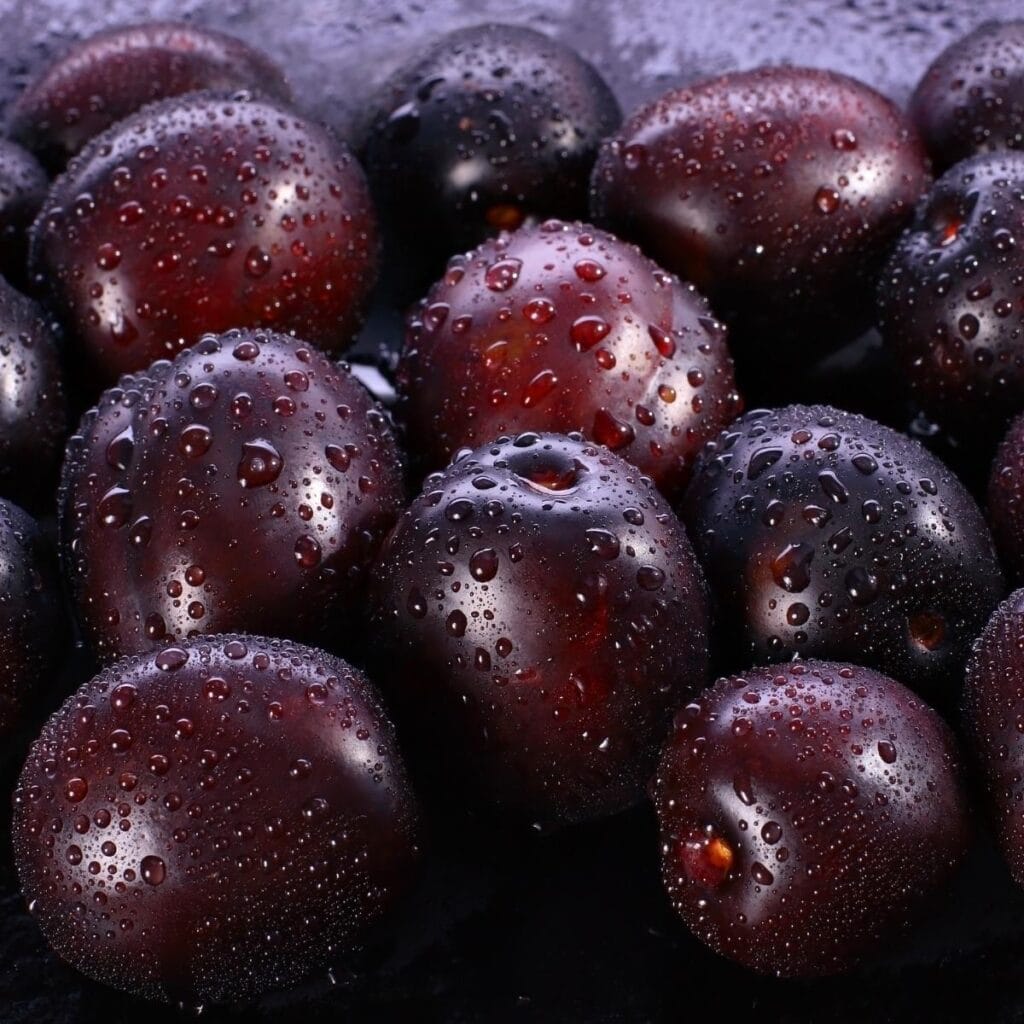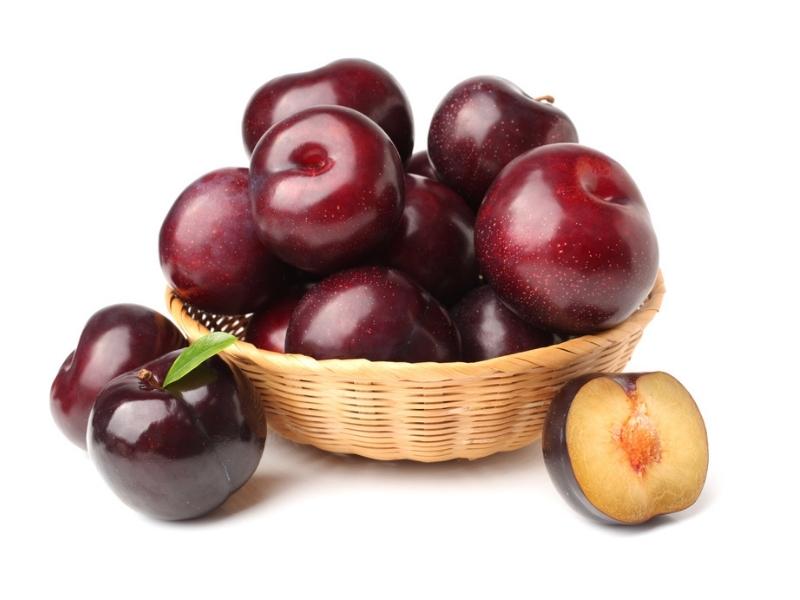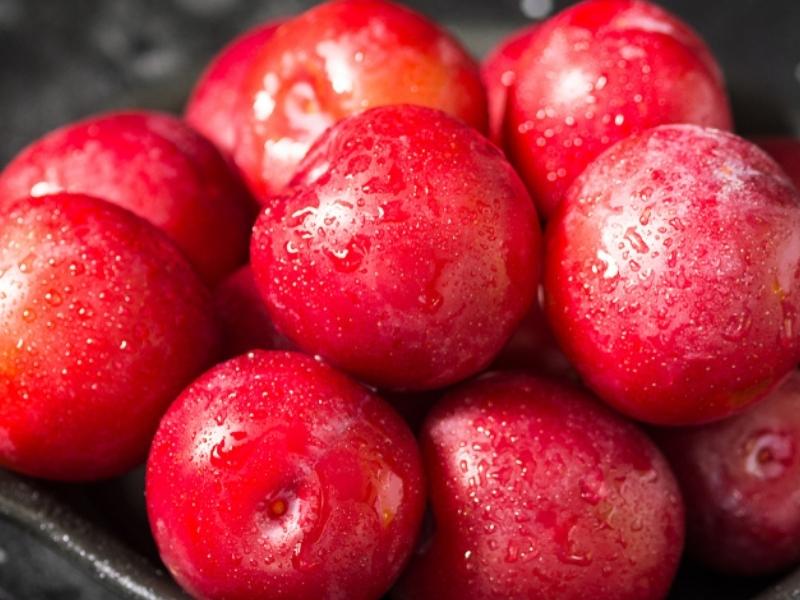Did you know that there is more than just one variety of plums? Learn all about the 20+ types of plums, only here!
Sweet, firm, and juicy, plums are great either enjoyed raw or incorporated in desserts.
Just like cherries and peaches, they’re also an excellent source of vitamins and antioxidants.

You’re probably only familiar with one type of plum, and it’s most likely the purple, oval fruit with a pit in the middle.
But here’s a fun fact: there are over 20 varieties of plums, each with its own color, shape, and flavor.
Read on and discover the many delicious and nutritious types of plums!
What is a Plum?
A plum is a fleshy and juicy fruit related to peaches and cherries.
It’s oval-shaped and smooth-skinned, with colors varying from bluish-purple to yellow.
Plums can be eaten raw, cooked, and dried. When dried, they’re called prunes.
As I said, there are over 20 different types of plums, and I’ll tell you all about them below.
20+ Different Types of Plums
The first thing you should know is that plums fall under 2 main categories: Japanese and European plums.
1. Japanese Plums (Chinese Plums)

Prunus Salicina or Japanese plums are round and grow up to about 2 inches in diameter.
Their skin color ranges from yellow & red to blue & purple, and even black.
Japanese plums, especially black ones, are ideal for desserts because their deep purple hue spreads beautifully into any dish.
Many Japanese plum trees don’t self-fruit.
They have to be planted and pollinated with another plum tree of a different variety in order to bear fruit.
Bear in mind (pun intended) though, that Japanese and European plum varieties cannot and will not cross-pollinate.
So, if you plan to plant non-self-fruiting plums, be sure to pair them with a variety of the same category.
Popular Japanese plums include the following:
2. Black Splendor

Black Splendor has bluish-black skin and a moist, reddish flesh. It’s typically larger than an average plum.
The fruit is tart, but its richness and sweetness balance out the acidity well.
Black Splendor falls under the clingstone variety, which means its pit doesn’t separate cleanly from its flesh.
3. Black Ruby

Black Ruby plums are round with reddish brown skin and yellow-orange flesh.
They fall under the freestone variety, so you can expect the pits to separate cleanly from the flesh.
Black Rubies are juicy with a dominantly sweet and mildly acidic flavor.
4. Friar

The friar is a variety of black plum with dark-violet skin, honey-colored flesh, and a relatively small pit.
Its flesh is firm, meaty, and juicy, with a mildly sweet flavor. Together with its tart skin, they make a pleasant flavor contrast.
Because of their similarities in taste, texture, and color, the friar is often associated with the black-skinned apricot.
As a freestone, its small pit separates easily from the flesh.
5. Black Beauty

The black beauty is known for its deep purple hue and its incredibly juicy and mildly sweet flavor. It definitely lives up to its name!
These plums range from medium to large sizes. Their flesh is firm but wildly juicy, making them ideal for eating fresh.
But because of their firmness, they’re also considered one of the best plums for making tarts and other baked goods.
6. Lemon

Lemon or yellow plums are a smaller and rounder Japanese plum variety.
As their name suggests, they’re yellow in color, in both the skin and the flesh.
They’re firm, crisp, and tart when unripe.
At this stage, you can sprinkle the fruit with salt and enjoy it as a wonderfully acidic, puckery snack.
Once they ripen, they’ll be sweet enough to be eaten fresh on their own or used as a yogurt or salad topping.
Yellow plums are also great for making pie or dessert filling, jams, and juices too.
In fact, 90% of yellow plums are made into jam or brandy!
7. Blood Plum

Blood plums have dark red skin and flesh. The flesh is firm and plump, with a super sweet flavor and a subtle tartness.
The balance of flavors in this plum variety is beyond excellent!
Aside from their impeccable taste and texture, blood plums are also highly nutritious.
They’re a fantastic source of antioxidants and are also great for preventing heart disease.
They’re also ideal for alleviating constipation, high blood pressure, and anxiety.
8. Black Amber

Black ambers are large with a near-black hue. When ripe, the flesh turns pale yellow and becomes fleshy and juicy.
That said, this variety is excellent when eaten raw. But you can also use it to make sauces and fruit fillings.
Black ambers are also rich in Vitamin A, so if you’re having problems with your eyes, add this plum variety to your diet!
9. Early Golden

While it originated in Canada, early golden is a Japanese plum variety.
A chance seedling, this plum variety only came to be through unintentional breeding.
What a wonderful accident!
The fruit is small to medium in size, but it is packed with big flavors.
It has golden yellow skin with a blush of red. The skin is tart, but the flesh is intensely sweet.
As a freestone fruit, its pit separates cleanly from the flesh.
10. Elephant Heart

True to its name, the elephant heart is a heart-shaped plum. When ripe, its flesh becomes deep red in color.
The Elephant Heart is tart and sweet with a floral flavor. As a freestone, this plum’s pit doesn’t cling to the flesh.
You can either eat it raw or incorporate it into desserts.
11. Santa Rosa

The Santa Rosa is a variety of Japanese plums that are self-pollinating. It means you can plant the tree on its own and it’ll bear fruit.
This plum is large with a red and purple hue. They’re a clingstone variety, so expect the pit to cling to its flesh.
Santa Rosas can be eaten fresh, but you can also use them in cooking and baking. They’re also great when canned.
12. Simka

Simkas are Japanese plums with reddish skins and a bluish-purple waxy coating.
Their flesh is golden with pits clinging to their flesh.
Simka plums are large and heart-shaped with sweet and juicy flesh.
13. European or Italian Plums

The European or Italian plum, also referred to as Prunus Domestica, is a dry plum variety with an oval shape.
Oftentimes, markets would label this plum as “fresh prunes.”
This species of plum was first cultivated in Syria, then in Rome.
The Romans then introduced the plum to Europeans during the crusades.
Most European plum trees are self-pollinating. But you’ll get better-tasting fruits when you cultivate them with another variety.
However, take note that European and Japanese plums will not cross-pollinate.
That said, be sure to plant plum trees of the same category.
Some of the most popular ones include the following:
14. Moyer

The Moyer plum is widely considered the best European plum. They’re oval-shaped and plump with a pleasantly sweet taste.
Another great thing about the Moyer is that it retains its sweetness even when dried. It’s also excellent for making jams and jellies.
Because it’s so sweet, the Moyer plum is sometimes labeled as a “sugar plum.”
For the best and most abundant growth, plant the Moyer tree with another European plum variety, such as the Brooks plum.
15. Greengage

Because they’re green, greengage plums are often perceived as unripe and therefore, sour and not sweet at all.
Surprisingly, though, mature greengages actually have the highest sugar level among European plums!
Their flesh is dense and juicy. They’re sweet like honey with a subtle citrus acidity.
Their phenomenal flavor makes them great for making pies, cakes, jams, compotes, and other desserts.
Greengage plums pair well with vanilla, chocolate, citrus and tropical fruits, and butter.
You can also serve them alongside savory food like seafood, lamb, cheese, and bacon.
Aside from their wonderfully unique flavor, greengage plums are an excellent source of Vitamins A, C, and K.
They’re also packed with potassium and phosphorous.
16. Mirabelle

Also called cherry plums, Mirabelle plums are small, sweet, and syrupy.
They’re an ideal candidate for making baked goods, jams, jellies, and fruit brandy.
Mirabelles are so rare, they’re almost exclusively grown in France.
You can grow the tree yourself, but a Mirabelle isn’t a genuine Mirabelle if it’s not grown in France.
17. Plucot

Not to be confused with the plumcot and the pluot, the plucot is a hybrid between a plum and an apricot.
A pluot, on the other hand, is a plum with characteristics similar to an apricot.
Confusing, amirite?
Here’s what you need to know about the plucot, though. It’s firm, crisp, and delicious.
It has yellowish-green skin with patches of reddish-blue, while its flesh ranges from bright pink to red.
The plucot plum is most commonly used in making mint salsa, but you can also turn it into jam or chutney.
Because of its firm and crisp flesh, the plucot plum can be easily transported to other countries without getting damaged.
18. Damson

Damascene or damson is a fleshy European plum variety mostly found in Great Britain.
The Damson tree bears small fruits with vivid dark blue flesh.
They have a large pit in the middle, surrounded by incredibly juicy flesh.
They’re so exceptionally tart and sour that you can’t really eat them when raw.
Rich in fiber, Damson plums are great for aiding digestion.
They also help lower bad cholesterol, prevent heart diseases, and reduce the risk of certain cancers.
So, despite their acidic taste, you should definitely consider adding them to your diet.
Stew the plums to sweeten them and counter their tartness. Serve with whipped cream on top and enjoy.
19. Cherry Plums

Cherry plums are soft and juicy with a bright and bold flavor.
They’re somewhat tart, but their sweetness balances things out well.
This plum variety helps with metabolism and is also good for your nervous system.
20. French Prune

The French plum or prune has deep, reddish-black skin and autumn gold flesh.
Just like most European plums, it is able to bear fruit on its own.
Only mild in flavor, French prunes are great for drying or canning.
21. El Dorado

The El Dorado plum has dark skin and amber flesh.
The flesh is intensely sweet, while the skin is sour. Together, they make a great flavor balance.
While it tastes good when fresh and raw, its firm texture also makes El Dorado ideal for baking and cooking.
22. Italian Plum

The Italian plum is a dwarf tree that bears fruit on its own. Its fruits are small and egg-shaped, with a black hue.
Their skin is smooth and their flesh is wonderfully sweet.
They’re great for making prunes, but their sweetness also makes them great for snacking.











